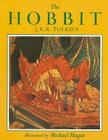I love The Runaway Bunny with its amazing pictures that one can just climb into. It's a book for a very young child, describing the world a child sees. During those toddler stages of exploring the world then wanting to cling, it reassures. Having said that, I will confess that I didn't read it to my own children when they were that little. As you know, one of the traumatic moments of my early motherhood was when 22 month-old Lizzie walked out the door in our urban neighborhood, closing it behind her, and toddled happily toward a six-lane major thoroughfare at the end of our block. I figured out where she'd gone and caught up with her before she got there, but the whole incident was heart-stopping. Somehow, reading a book where the thrill of running away was so beautifully presented, and the message that mom will always come after you (as I did) led me to fear that the book would encourage her roving tendencies.
 An older fan of another rabbit book came to the store yesterday: a sixth grader who loves
An older fan of another rabbit book came to the store yesterday: a sixth grader who loves Watership Down, by Richard Adams. It tells the story of a group of rabbits who leave their home when one of them predicts its destruction. They go on an odyssey through several different types of rabbit communities before establishing -- and having to defend -- their new home on Watership Down. It's big and rich in adventure, heroism and competing philosophies of what society should be. I wonder if it's one of the books that your high school students talk about having loved a few years earlier. The sixth-grader's father said that in searching for other books she might like as much, he ran into recommendations speaking to the utopian/dystopian themes, like 1984, and Brave New World. He was hoping for something else --- "not as dark" was his request.
 I love this kind of request, but I also often wish I had a few hours and several different people to chat with before I charge into recommendations. That's not how it works, though -- so I flailed around for a bit and came up with two possibilities. First I suggested
I love this kind of request, but I also often wish I had a few hours and several different people to chat with before I charge into recommendations. That's not how it works, though -- so I flailed around for a bit and came up with two possibilities. First I suggested The Sword in the Stone, by T. H. White (author of Mistress Masham's repose, which we've praised here and here). It's the story of King Arthur's childhood, the first part of The Once and Future King. It's a big meaty book, full of humor and good writing. Wart, as the boy Arthur is called, grows -- literally and figuratively -- through the book. I'm particularly fond of the edition whose cover you see here: it has stunning occasional illustrations which stress Arthur's youth. Merlyn's education of Wart is the element which made me think of it for our sixth grader. He changes Wart into different animals so that he can experience different societies and attitudes toward the world. The boy becomes a hawk, a fish, an owl, a goose, an ant, and a badger.
 It didn't quite hit the spot with my 11 year-old customer, so we moved on to the epic element of Watership Down. Next stop: Lord of the Rings. I think it was attractive for its epic proportions, and for its stamp of you're-not-reading-little-kid-stuff-anymore. We discussed for a while whether she should just jump right into The Fellowship of the Ring, the first of the Lord of the Rings trilogy, or if she should read
It didn't quite hit the spot with my 11 year-old customer, so we moved on to the epic element of Watership Down. Next stop: Lord of the Rings. I think it was attractive for its epic proportions, and for its stamp of you're-not-reading-little-kid-stuff-anymore. We discussed for a while whether she should just jump right into The Fellowship of the Ring, the first of the Lord of the Rings trilogy, or if she should read The Hobbit first. It was written first, of course, and introduces Middle Earth, some of the characters, and it's where Bilbo obtains The Ring. It's a slightly easier read, not quite as dark as the trilogy which follows. She took The Fellowship of the Ring and went off in search of her father to discuss it. It was late, things were busy, and I didn't talk with her again. This morning I noticed that the book was back on the shelf, but The Hobbit was gone.
So there you have it, from rabbits to dragons.
Love,
Deborah

No comments:
Post a Comment